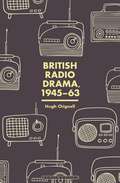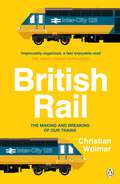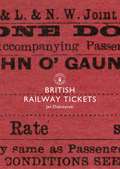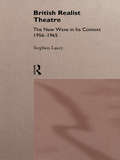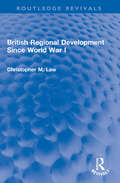- Table View
- List View
British queer history: New approaches and perspectives
by Brian LewisThis collection of essays takes stock of the ‘new British queer history’. It is intended both for scholars and students of British social and cultural history and of the history of sexuality, and for a broader readership interested in queer issues. In offering a snapshot of the field, this volume demonstrates the richness and promise of one of the most vibrant areas of modern British history and the complexity and breadth of discussion, debate and approach. It showcases challenging think-pieces from leading luminaries alongside some of the most original and exciting research by established and emerging young scholars. The book provides a plethora of fresh perspectives and a wealth of new information, suggests enticing avenues for research and – in bringing the whole question of sexual identity to the forefront of debate – challenges us to rethink queer history’s parameters.
British Radio Drama, 1945-63
by Hugh ChignellBritish Radio Drama, 1945-1963 reveals the quality and range of the avant-garde radio broadcasts from the 'golden age' of British radio drama. Turning away from the cautious and conservative programming that emerged in the UK immediately after World War II, young generations of radio producers looked to French theatre, introducing writers such as Samuel Beckett and Eugene Ionesco to British radio audiences. This 'theatre of the absurd' triggered a renaissance of writing and production featuring the work of Giles Cooper, Rhys Adrian and Harold Pinter, as well as the launch of the BBC Radiophonic Workshop. Based on primary archival research and interviews with former BBC staff, Hugh Chignell places this high-point in the BBC's history in the broader context of British post-war culture, as norms of morality and behavior were re-negotiated in the shadow of the Cold War, while at once establishing the internationalism of post-war radio and theatre.
British Radio Drama, 1945-63
by Hugh ChignellBritish Radio Drama, 1945-1963 reveals the quality and range of the avant-garde radio broadcasts from the 'golden age' of British radio drama. Turning away from the cautious and conservative programming that emerged in the UK immediately after World War II, young generations of radio producers looked to French theatre, introducing writers such as Samuel Beckett and Eugene Ionesco to British radio audiences. This 'theatre of the absurd' triggered a renaissance of writing and production featuring the work of Giles Cooper, Rhys Adrian and Harold Pinter, as well as the launch of the BBC Radiophonic Workshop. Based on primary archival research and interviews with former BBC staff, Hugh Chignell places this high-point in the BBC's history in the broader context of British post-war culture, as norms of morality and behavior were re-negotiated in the shadow of the Cold War, while at once establishing the internationalism of post-war radio and theatre.
British Rail
by Christian WolmarThe authoritative and fascinating history of the rise and fall of the state-owned British Rail'Wolmar's book is impeccably organized and makes a fast, enjoyable read' THE TIMES Literary Supplement________You think you know British Rail. But you don't know the whole story.From its creation after the Second World War, through its fifty-year lifetime, British Rail was an innovative powerhouse that transformed our transport system. Uniting disparate lines into a highly competent organisation - heralding 'The Age of the Train' - and, for a time, providing one of the fastest regular rail services in the world.Born into post-war austerity, traumatised, impoverished and exploited by a hostile press, the state-owned railway was dismissed as a dinosaur unable to evolve, and swept away by a government hellbent on selling it off.Now, award-winning writer Christian Wolmar provides a new perspective on national loss in a time of privatisation.British Rail is ripe for a new history._______Praise for Christian WolmarThe greatest expert on British trains' Guardian'Our most eminent transport journalist' Spectator'If the world's railways have a laureate, it is surely Christian Wolmar' Boston Globe 'Christian Wolmar is in love with the railways. He writes constantly and passionately about them. He is their wisest, most detailed historian and a constant prophet of their rebirth . . . if you love the hum of the wheels and of history, then Christian Wolmar is your man' Observer
British railway enthusiasm (Studies in Popular Culture)
by Ian CarterThe first book to study railway enthusiasts in Britain. The postwar train spotting craze swept most boys (and some girls, despite railways being coded as a male business) into a passion for railways. These people invigorated different sectors in railway enthusiasm’s life world - from railway modelling to Britain’s huge preserved railway industry.
British Railway Tickets (Shire Library)
by Jan DobrzynskiIn 1838 Thomas Edmondson, an employee of the fledgling Newcastle & Carlisle Railway, revolutionised the ticket issuing process in Britain and left an enduring legacy: the Edmondson ticket. Purchased as proof of the contract between passenger and railway company, the ticket was a receipt, travel pass and an ephemeral record of almost every train journey ever taken in the British Isles, reflecting the nostalgia of the railways and a period of history when the movement of millions of people brought together England, Ireland, Scotland and Wales. The railways printed millions of tickets for every conceivable journey and category of passenger. Most were destroyed after use, but remarkably many survive, in the care of libraries, museums and collectors, and form the basis of a fascinating hobby.
British Railway Tickets (Shire Library)
by Jan DobrzynskiIn 1838 Thomas Edmondson, an employee of the fledgling Newcastle & Carlisle Railway, revolutionised the ticket issuing process in Britain and left an enduring legacy: the Edmondson ticket. Purchased as proof of the contract between passenger and railway company, the ticket was a receipt, travel pass and an ephemeral record of almost every train journey ever taken in the British Isles, reflecting the nostalgia of the railways and a period of history when the movement of millions of people brought together England, Ireland, Scotland and Wales. The railways printed millions of tickets for every conceivable journey and category of passenger. Most were destroyed after use, but remarkably many survive, in the care of libraries, museums and collectors, and form the basis of a fascinating hobby.
British Railways in Argentina 1857-1914: A Case Study of Foreign Investment (History: Bloomsbury Academic Collections)
by Colin M. LewisLewis examines the complex combinations of British and Argentine forces involved in the rapid development of modern Argentina after its former pastoral and parochial socio-economic structure was superseded by the formation of a modern republic, which was largely financed by external sources and made it one of the most dynamic and prosperous countries of the mid and late 19th century. His work demonstrates the conflicting, often contradictory, expectations of the parties concerned, and how these divergent expectations and preconceptions were successfully harmonised and evolved.
British Railways in the 1950s and ’60s (Shire Library #699)
by Greg MorseAs Britain moved from austerity to prosperity in the 1950s and 1960s, it became clear that British Railways needed to modernise its equipment and rationalise its network if it was to hold its own in the face of growing competition from road and air transport. After attempting to maintain pre-war networks and technology in the 1950s, a reversal of policy in the 1960s brought line closures, new liveries and the last breath of steam, as Dr Beeching and his successors strove to break even and build a new business from the old. From Britannia to the 'Blue Pullman', Evening Star to Inter-City, Greg Morse takes us through this turbulent twenty-year period, which started with drab prospects and ended with BR poised to launch the fastest diesel-powered train in the world.
British Railways in the 1950s and ’60s (Shire Library #699)
by Greg MorseAs Britain moved from austerity to prosperity in the 1950s and 1960s, it became clear that British Railways needed to modernise its equipment and rationalise its network if it was to hold its own in the face of growing competition from road and air transport. After attempting to maintain pre-war networks and technology in the 1950s, a reversal of policy in the 1960s brought line closures, new liveries and the last breath of steam, as Dr Beeching and his successors strove to break even and build a new business from the old. From Britannia to the 'Blue Pullman', Evening Star to Inter-City, Greg Morse takes us through this turbulent twenty-year period, which started with drab prospects and ended with BR poised to launch the fastest diesel-powered train in the world.
British Railways in the 1970s and ’80s (Shire Library #753)
by Greg MorseFor British Rail, the 1970s was a time of contrasts, when bad jokes about sandwiches and pork pies often belied real achievements, like increasing computerisation and the arrival of the high-speed Inter-City 125s. But while television advertisements told of an 'Age of the Train', Monday morning misery continued for many, the commuter experience steadily worsening as rolling stock aged and grew ever more uncomfortable. Even when BR launched new electrification schemes and new suburban trains in the 1980s, focus still fell on the problems that beset the Advanced Passenger Train, whose ignominious end came under full media glare. In British Railways in the 1970s and '80s, Greg Morse guides us through a world of Traveller's Fare, concrete concourses and peak-capped porters, a difficult period that began with the aftershock of Beeching but ended with BR becoming the first nationalised passenger network in the world to make a profit.
British Railways in the 1970s and ’80s (Shire Library #753)
by Greg MorseFor British Rail, the 1970s was a time of contrasts, when bad jokes about sandwiches and pork pies often belied real achievements, like increasing computerisation and the arrival of the high-speed Inter-City 125s. But while television advertisements told of an 'Age of the Train', Monday morning misery continued for many, the commuter experience steadily worsening as rolling stock aged and grew ever more uncomfortable. Even when BR launched new electrification schemes and new suburban trains in the 1980s, focus still fell on the problems that beset the Advanced Passenger Train, whose ignominious end came under full media glare. In British Railways in the 1970s and '80s, Greg Morse guides us through a world of Traveller's Fare, concrete concourses and peak-capped porters, a difficult period that began with the aftershock of Beeching but ended with BR becoming the first nationalised passenger network in the world to make a profit.
The British Raj: Keywords
by Pramod K. NayarFor two hundred years India was the jewel in the British imperial crown. During the course of governing India – the Raj – a number of words came to have particular meanings in the imperial lexicon. This book documents the words and terms that the British used to describe, define, understand and judge the subcontinent. It offers insight into the cultures of the Raj through a sampling of its various terms, concepts and nomenclature, and utilizes critical commentaries on specific domains to illuminate not only the linguistic meaning of a word but its cultural and political nuances. This fascinating book also provides literary and cultural texts from the colonial canon where these Anglo-Indian colloquialisms, terms and official jargon occurred. It enables us to glean a sense of the Empire’s linguistic and cultural tensions, negotiations and adaptations. The work will interest students and researchers of history, language and literature, colonialism, cultural studies, imperialism and the British Raj, and South Asian studies.
The British Raj: Keywords
by Pramod K. NayarFor two hundred years India was the jewel in the British imperial crown. During the course of governing India – the Raj – a number of words came to have particular meanings in the imperial lexicon. This book documents the words and terms that the British used to describe, define, understand and judge the subcontinent. It offers insight into the cultures of the Raj through a sampling of its various terms, concepts and nomenclature, and utilizes critical commentaries on specific domains to illuminate not only the linguistic meaning of a word but its cultural and political nuances. This fascinating book also provides literary and cultural texts from the colonial canon where these Anglo-Indian colloquialisms, terms and official jargon occurred. It enables us to glean a sense of the Empire’s linguistic and cultural tensions, negotiations and adaptations. The work will interest students and researchers of history, language and literature, colonialism, cultural studies, imperialism and the British Raj, and South Asian studies.
British Realist Theatre: The New Wave in its Context 1956 - 1965
by Stephen LaceyThe British `New Wave' of dramatists, actors and directors in the late 1950s and 1960s created a defining moment in post-war theatre. British Realist Theatre is an accessible introduction to the New Wave, providing the historical and cultural background which is essential for a true understanding of this influential and dynamic era. Drawing upon contemporary sources as well as the plays themselves, Stephen Lacey considers the plays' influences, their impact and their critical receptions. The playwrights discussed include: * Edward Bond * John Osborne * Shelagh Delaney * Harold Pinter
British Realist Theatre: The New Wave in its Context 1956 - 1965
by Stephen LaceyThe British `New Wave' of dramatists, actors and directors in the late 1950s and 1960s created a defining moment in post-war theatre. British Realist Theatre is an accessible introduction to the New Wave, providing the historical and cultural background which is essential for a true understanding of this influential and dynamic era. Drawing upon contemporary sources as well as the plays themselves, Stephen Lacey considers the plays' influences, their impact and their critical receptions. The playwrights discussed include: * Edward Bond * John Osborne * Shelagh Delaney * Harold Pinter
British Redcoat 1740–93 (Warrior)
by Richard Hook Stuart ReidDuring this period, the British army earned itself a formidable reputation as a fighting force. However, due to its role as a police force at home, and demonisation by American propaganda, the army was viewed as little removed from a penal institution run by aristocratic dilettantes. This view, still held by many today, is challenged by Stuart Reid, who paints a picture of an increasingly professional force. This was an important time of change and improvement for the British Army, and British Redcoat 1740-1793 fully brings this out in its comprehensive examination of the lives, conditions and experiences of the late 18th-century infantryman.
British Redcoat 1740–93 (Warrior #No. 19)
by Richard Hook Stuart ReidDuring this period, the British army earned itself a formidable reputation as a fighting force. However, due to its role as a police force at home, and demonisation by American propaganda, the army was viewed as little removed from a penal institution run by aristocratic dilettantes. This view, still held by many today, is challenged by Stuart Reid, who paints a picture of an increasingly professional force. This was an important time of change and improvement for the British Army, and British Redcoat 1740-1793 fully brings this out in its comprehensive examination of the lives, conditions and experiences of the late 18th-century infantryman.
British Redcoat vs French Fusilier: North America 1755–63 (Combat)
by Peter Dennis Stuart ReidProviding a unique glimpse into the experiences of regular British and French infantry during the French and Indian War, Stuart Reid reveals what it was like to fight in three battles at the height of the struggle for Canada: La Belle-Famille, the Plains of Abraham and Sainte-Foy. In 1755, Britain and France both decided to escalate a low intensity frontier war that had started the previous year by dispatching regular troops to their respective colonies in North America. Far from home, both sides' equipment and tactics were initially more suited to the European theatre. As the war ground on, however, combat doctrine evolved as both armies learned lessons that would be utilized by succeeding generations of soldiers. Packed with first-hand accounts, dramatic illustrations and a technical analysis of the changing nature of warfare on the American continent, this book puts readers in the shoes of the combatants who played a pivotal role in shaping the future of North America.
British Redcoat vs French Fusilier: North America 1755–63 (Combat)
by Peter Dennis Stuart ReidProviding a unique glimpse into the experiences of regular British and French infantry during the French and Indian War, Stuart Reid reveals what it was like to fight in three battles at the height of the struggle for Canada: La Belle-Famille, the Plains of Abraham and Sainte-Foy. In 1755, Britain and France both decided to escalate a low intensity frontier war that had started the previous year by dispatching regular troops to their respective colonies in North America. Far from home, both sides' equipment and tactics were initially more suited to the European theatre. As the war ground on, however, combat doctrine evolved as both armies learned lessons that would be utilized by succeeding generations of soldiers. Packed with first-hand accounts, dramatic illustrations and a technical analysis of the changing nature of warfare on the American continent, this book puts readers in the shoes of the combatants who played a pivotal role in shaping the future of North America.
British Regional Development Since World War I (Routledge Revivals)
by Christopher M. LawFirst published in 1981, British Regional Development Since World War I presents a comprehensive and balanced introduction to the problems of regional development in Britain. Since World War I it has been possible to talk of Britain as two nations, a prosperous South including the Midlands, and a poor North. Christopher Law examines the nature and causes of this division, including impact of industrial structure, London’s role as capital in the spatial economy, and the influence of better environments on development. This valuable study will be an essential read for anyone interested in any aspect of regional development and development studies in the last ninety years.
British Regional Development Since World War I (Routledge Revivals)
by Christopher M. LawFirst published in 1981, British Regional Development Since World War I presents a comprehensive and balanced introduction to the problems of regional development in Britain. Since World War I it has been possible to talk of Britain as two nations, a prosperous South including the Midlands, and a poor North. Christopher Law examines the nature and causes of this division, including impact of industrial structure, London’s role as capital in the spatial economy, and the influence of better environments on development. This valuable study will be an essential read for anyone interested in any aspect of regional development and development studies in the last ninety years.
British Representations of the Middle East in the Exhibition Space, 1850–1932: Race, Gender, and Morality (Routledge Studies in Cultural History)
by Holly O'FarrellThis volume analyses British exhibitions of Middle Eastern (particularly ancient Egyptian and Persian) artefacts during the nineteenth and early twentieth centuries – examining how these exhibitions defined British self image in response to the Middle Eastern ‘other’. This study is an original interpretation of the exhibition space along intersectional constructionist lines, revealing how forces such as gender, race, morality and space come together to provide an argument for British supremacy. The position of museums as instruments of representation of display made them important points of contact between the British national imperialist scheme and the public. Displays in the British Museum, Victoria and Albert Museum and Burlington House provide a focus for analysis. Through the employment of a constructionist lens, the research outlines a complex relationship between British society and the Middle Eastern artefacts presented in museums during the nineteenth and early twentieth centuries. This allows a dialogue to emerge which has consequences for both societies which is achieved through intersections of gender, race and morality in space. This book will be of value to students and scholars alike interested in museology, cultural studies, history and art history.
British Representations of the Middle East in the Exhibition Space, 1850–1932: Race, Gender, and Morality (Routledge Studies in Cultural History)
by Holly O'FarrellThis volume analyses British exhibitions of Middle Eastern (particularly ancient Egyptian and Persian) artefacts during the nineteenth and early twentieth centuries – examining how these exhibitions defined British self image in response to the Middle Eastern ‘other’. This study is an original interpretation of the exhibition space along intersectional constructionist lines, revealing how forces such as gender, race, morality and space come together to provide an argument for British supremacy. The position of museums as instruments of representation of display made them important points of contact between the British national imperialist scheme and the public. Displays in the British Museum, Victoria and Albert Museum and Burlington House provide a focus for analysis. Through the employment of a constructionist lens, the research outlines a complex relationship between British society and the Middle Eastern artefacts presented in museums during the nineteenth and early twentieth centuries. This allows a dialogue to emerge which has consequences for both societies which is achieved through intersections of gender, race and morality in space. This book will be of value to students and scholars alike interested in museology, cultural studies, history and art history.

